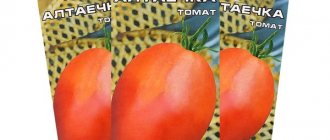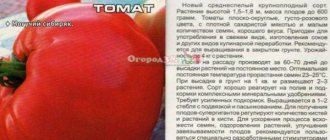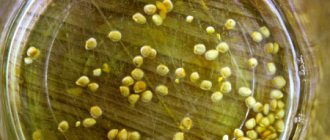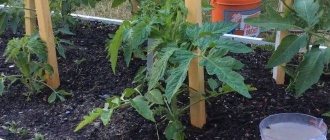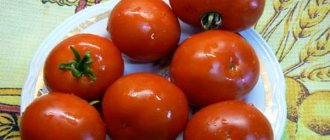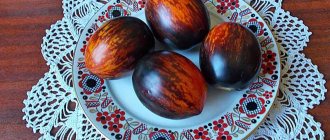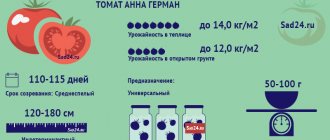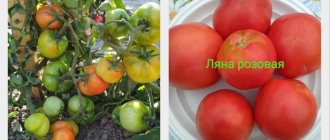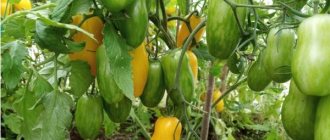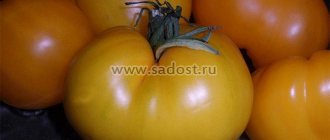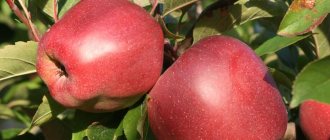Russian breeders continue to delight lovers of early-ripening tomatoes. Hybrid Donna Anna F1 combines many valuable qualities that gardeners love.
| Height | Landing location | Ripening time | Fruit color | Fruit size | Origin | Fruit shape |
| Medium height | Greenhouse, Open ground | Early ripening | Reds | Average | Hybrid | Round |
Features of fruits and yield indicators
The characteristics of the tomato variety indicate that the tomato belongs to the early ripening varieties.
The average period of fruit ripening from the moment of planting is from 93 to 98 days. Tomato bushes are medium-sized, the height of an adult plant is from 1.6 to 1.7 meters. The shoots of the plant are distinguished by powerful, durable stems that can withstand heavy bunches of fruit. The first brush of a plant with inflorescences is laid over the 5th, 6th or 7th leaf, the subsequent ones are formed through 1 or 2 leaf blades. The formation of fruits in one cluster is 5 or 6 tomatoes. Description of tomato:
- have a round shape;
- have a smooth surface;
- there is a small neat spout at the top of the vegetable;
- have a dense structure;
- are multi-chamber.
Tomato Donna Anna f1 has a characteristic red color without green spots at the base. The average weight of one fruit varies from 185 to 200 grams. From 1 m2, subject to the rules of agricultural technology, up to 14.7 kg is removed.
Tomatoes withstand transportation difficulties well and do not crack. The variety is suitable for all types of processing, including canning and making various types of winter preparations. Gardeners note the excellent quality of tomato juice obtained from this type of tomato.
Description and characteristics of the variety
The hybrid belongs to the group of semi-determinate tomatoes, the plant height is from 1.5 to 1.7 meters. The hybrid is early ripening, fruiting begins 93-98 days from the date of planting. Tomatoes are characterized by strong, powerful stems that can support the weight of bunches of ripe fruit. The inflorescence is simple, the first one is formed at the level of 5-7 leaves, the next ones - after 1-2 leaves.
The cultivation of this hybrid is not limited to private farms; it can be grown on an industrial scale for subsequent sale or processing.
The leaves are light green, standard in shape for tomatoes, there are not many of them on the plant. The shape of the tomatoes is unusual - round with a small “spout”, more reminiscent of a turnip, and looks very aesthetically pleasing. Dense, multi-chambered fruits of a rich red color, without spots or cracks.
Donna Anna – variety of Tomato plant
Information about the admission of Tomato Donna Anna from the Register of the State Variety Commission of the Russian Federation
Application for admission No. 52583, registered 2009-09-07. The Tomato variety Donna Anna was included in the register of those approved in 2010. Approved for use in the regions: Northern, Northwestern, Central, Volga-Vyatka, Central Black Earth, North Caucasus, Middle Volga.
The originator of the Tomato variety Donna Anna is:
Other varieties of tomato plant
Question to the portal experts
If you haven't found the answer to a question, don't hesitate to ask an expert.
Have you already planted Tomato Donna Anna?
Tell us if you liked this variety? Will you plant it again?
Register or Login so you don't have to enter your Name and Email every time
Thanks for the comment! It will be published after checking by a moderator!
No comments yet, be the first!
A portal for those who love their dacha
Your question has been sent for moderation. Don't worry, we quickly check your questions and your question will be answered within 1 day.
We have noticed that you are already registered on our website. We recommend that you log in to view the created question.
If you don't remember your password, you can recover it.
You were not registered until today, so we have registered you. Your password has been sent to your specified mailbox.
Help our site develop!
Please read this message, it will not take up much of your time!
We so need your comments and questions to understand in which direction we should develop.
Don't forget to leave a comment if you found what you were looking for. And if you haven’t found it, use the “Ask an Expert” form in the site header. We will answer this question, and other visitors will be able to find the information that you could not find.
Your question has been sent for moderation. Don't worry, we quickly check your questions and your question will be answered within 1 day.
We have noticed that you are already registered on our website. We recommend that you log in to view the created question.
If you don't remember your password, you can recover it.
You were not registered until today, so we have registered you. Your password has been sent to your specified mailbox.
Characteristics of the variety
The distinctive features of this tomato variety indicate that it belongs to the types of early ripeness. On average, fruits ripen (from planting to harvest) in 93-98 days. The bushes have an average height, which usually reaches 1.6-1.7 meters. The power and strength of the shoot stems allows them to hold heavy bunches of tomatoes. The formation of the first brush of a bush with inflorescences occurs above the fifth, sixth or seventh leaf, the formation of the next ones is carried out through one or two leaf plates. Five or six fruits are formed on each cluster.
Experienced gardeners describe the resulting harvest as follows:
- the fruits are round in shape;
- the surface of tomatoes is smooth and dense;
- fruits are multi-chambered.
Tomatoes of this species have a characteristic red color; there are no green spots near the base. On average, the weight of each tomato is 185-200 g. If the rules of agricultural technology are followed, about 14.7 crops can be harvested from one square meter.
Donna Anna tomatoes are easily transported without cracking. The purpose of these tomatoes is universal. They can be preserved and used to prepare various preparations for the winter. Gardeners who grow Donna Anna tomatoes say that the juice prepared from them is of very high quality.
Protection from pests and diseases
At the first signs of strawberry spotting, you need to cut off diseased leaves and treat the plantings with a solution of Fitosporin.
This microbiological agent belongs to a new generation of drugs that effectively fight fungal and bacterial diseases.
Fitosporin is used as a means of combating diseases such as:
- powdery mildew;
- black rot;
- white spotting;
- bacteriosis;
- scab;
- bacterial cancer.
The drug is produced by the manufacturer in 3 types: powder, paste and liquid.
Guapsin
Treating strawberries with an aqueous suspension of Guapsin reduces the likelihood of diseases and pest damage.
Another popular means of prevention is Guapsin. This is a broad-spectrum biological product. It contains live bacteria and their metabolic products, as well as initial doses of microelements such as potassium, phosphorus and sodium.
The main advantages of Guapsin:
- no effect on the taste of strawberries;
- non-toxic;
- the product does not accumulate in the soil.
In the fall, fertilizing is necessary, since after the autumn harvest the plant increases its vegetative mass, the quality of which will affect the yield of the next year.
Growing Tips
Donna Anna tomatoes are suitable for planting not only in a greenhouse, but also in open ground. The seedlings are brought to a permanent place approximately 50-60 days after sowing. For seed germination, it is better to maintain a temperature of +23…+25°C.
The advantages of hybrid varieties are well known, including the excellent ability of plants to withstand heat, resistance to various nightshade diseases and stress, as well as rapid recovery from them.
Tomatoes are practically not susceptible to diseases, they are especially resistant to the tobacco mosaic virus, and easily tolerate blossom end and root rot and Alternaria blight.
Reviews from experienced gardeners indicate that 3 plant bushes will be the optimal number for planting per 1 m².
The first brush of a plant with inflorescences should be located after the 6th or 7th leaf. During the growing process, 1 or 2 main stems are left, while all other shoots and side shoots must be removed. Since the bushes reach quite a large height, they need to be tied to a support.
The Donna Anna F1 tomato has a characteristic even red color without any green or yellow spots, which in other varieties are often located at the base.
When growing, it is necessary to carry out periodic weeding and loosening; in general, this type of tomato requires standard agricultural techniques.
Features compared to other varieties and hybrids
Amateur vegetable growers, when recommending certain tomatoes to each other, often voice entire lists of varieties and hybrids, united by common characteristics. Early and productive Anyuta is put on a par with tomatoes such as:
- Katya, judging by the description from the State Register, is a twin variety of Anyuta. Katya has the same fruits, bush type and yield, and is resistant to the same diseases. Perhaps it has a richer and sweeter taste, since tomatoes contain slightly more dry matter - 4.6% versus 3.8% for Anyuta and sugars - 2.4% versus 1.6%. Other differences can be found when growing both hybrids in the same bed.
- Junior ripens in 80–85 days, the fruits weigh up to 100 g and have an excellent taste. The yield is similar - 9–9.9 kg/m². This hybrid is approved for cultivation in all regions.
- Sanka is a very popular variety, zoned for the Central Black Earth Region. When fresh, the fruits are not as tasty as we would like, but they are excellent for whole-fruit canning. Tomato productivity is at a height of 13–15 kg/m².
Anyuta is zoned and shows her best qualities only in the south of the Russian Federation. If you live, like me, in Siberia or another region with capricious summers, then I can recommend two tomatoes from the same category: Lyana and Yablonka of Russia. I grew them last summer. The tomatoes are not large (up to 100 g), but there are a lot of them on the bushes, they hang in clusters, and they are the first to ripen in the garden (already in July). Of course, they are not meaty, like Ox’s heart or Sevruga, there are a lot of seeds and juice inside, but as the first tomatoes of the season, when you don’t have to choose, they are very pleasing both in appearance and taste.
The main disadvantage of Anyuta is that it is not zoned for all regions; in addition, there are determinant early-ripening tomatoes, although only slightly, but they are more productive and tastier.
Tomato Anyuta: description and characteristics of the variety, cultivation features, reviews, photos
The Anyuta tomato has been grown by gardeners for about 20 years. Considered one of the best for growing outdoors. The reason for its popularity is its good yield against the backdrop of a low-growing shrub. If you are not yet familiar with Anyuta, it is worth planting and trying a few shrubs. Maybe you'll find this hybrid to suit your taste.
Description of the tomato Anyuta
This is a hybrid and not a variety patented by Semco Junior. The tomato was tested and entered into the State Register of Breeding Successes, with permission for breeding only in one region - in the North Caucasus, i.e. almost in the extreme south of our country. However, Anyuta is grown in all corners of Russia, as it is an ancient and undemanding tomato.
Infographics: a brief description of the Anyuta tomato variety according to the State Register
Brief description of the Anyuta tomato according to the state register
From germination to the first harvest, only 75-80 days pass! Determinate shrub, height 60-70 cm. The first fruit bush is placed on 6-7 leaves, sometimes on 5, the next one - after 1-2 leaves, with 7 fruits in each hand.
The Anyuta bush is not tall, the brushes are placed on the ground itself, each with up to 7 fruits
standard size tomatoes for this crop are 86-100 g, maximum - 120 g. Their shape is flat and round, without ribs. There is no dark spot on the stem, the fruit is evenly colored over the entire surface.
The cellulose is dense and contains 4 or more seed chambers. Professional tasters rated the taste as 'good' and 'excellent'. Vacationers say that there are tastier tomatoes, only later they ripen the ultra-fruit Anyuta.
So he is very suitable as the first supplier of tomatoes.
Anyuta tomatoes are juicy, on average there are more than 4 chambers
There are also a number of undeniable advantages: the fruits do not tear, do not develop rot, the hybrid is resistant to tobacco mosaic and is little susceptible to late blight. Moreover, Anyuta is distinguished not only by its early harvest, but also by its friendly yield.
By the time the cold morning arrives (the cause of fungal diseases), the tomatoes are already ripe and cleared from the beds. Tomato yield is decent - 8-10 kg/m² outdoors and 14 kg/m² in greenhouses and greenhouses.
Not every large and large tomato is capable of such productivity.
Features compared to other varieties and hybrids
Amateur vegetable growers who recommended several tomatoes to each other often expressed a whole list of varieties and hybrids with common characteristics. Early and old Anyuta is placed on the same level as tomatoes, for example:
- Katya is a double variety of Anyuta as described in the state registry. Katya has the same fruits, the same type of bush and yield, she is resistant to the same diseases. It may have a richer and sweeter taste, since tomatoes contain slightly more dry matter - 4.6% compared to Anyuta's 3.8% and sugar's 2.4%. Further differences can be found when both hybrids are grown in the same bed.
Katya is also a productive and beautiful tomato
- The youngest ripens in 80-85 days, the fruits are watered up to 100 g, and have an excellent taste. The yield is similar - 9-9.9 kg/m². This hybrid can grow in all regions.
Junior is an early hybrid for all regions
- Sanka is a very popular variety, zoned for the Central Black Earth. Fresh fruit doesn't taste as good as you'd like, but it does a great job of preserving whole fruit. Tomato productivity in height is 13-15 kg/m².
Anyuta is found only in the south of Russia and shows its best qualities. If, like me, you live in Siberia or any other region with dreary summers, I can recommend two tomatoes from the same category: Liana and Russia apple. I cultivated them last summer.
Rules of care
Tomatoes can be successfully grown in open beds and greenhouses. Initially, seeds are sown for seedlings, after which they are transplanted into the ground. It should be sown at such a time that there are 50-60 days left before planting in a permanent place.
When germinating seeds, it is recommended to ensure that the temperature is 23-25 degrees.
The hybrid has advantageous differences in comparison with other varieties. Positive qualities include the following:
- The plant tolerates heat well.
- The variety is resistant to diseases and viruses (tobacco mosaic, root and blossom end rot, etc.).
- The tomato is resistant to stress and also quickly recovers from stress.
When planting seedlings in the ground, you need to ensure that there are no more than three bushes per square meter of soil. When growing a Donna Anna tomato, you need to leave 1-2 main stems and remove the other stepsons. Tomato bushes need to be additionally tied up due to their growth characteristics.
The hybrid responds to fertilizing with organic and mineral fertilizers and traditional agricultural practices. The bushes must be periodically loosened and weeded.
For its excellent taste and many positive characteristics, the Donna Anna tomato is chosen by more and more gardeners, planting it on their plots.
tomato Jane - description and characteristics of the variety
Tomato Donna Anna: characteristics and description of a hybrid variety with photos
The Donna Anna tomato is a hybrid variety developed by Russian breeders quite recently. However, this type of tomato, distributed on the Russian agricultural market, quickly gained popularity among domestic gardeners. The undeniable advantages of the Donna Anna tomato variety are high yields, excellent marketability and taste.
Description of the properties of tomato
A distinctive feature of this type of vegetable is the presence of a real tomato aroma, which in most cases is absent in other tomato varieties bred by breeders over the past decades.
Characteristics and description of Donna Anna tomatoes can be reduced to the following main indicators:
- refers to early ripening varieties: the period of full ripening from the beginning of planting seedlings in the ground ranges from 93 to 98 days;
- bushes reach a height of 1.7 m;
- the plant has strong, rigid stems, which, due to their power, can easily withstand the weight of bunches of fruit;
- 1 cluster can ripen up to 5-6 fruits;
- tomato fruits are round, multi-chambered, with a smooth, even surface;
- the characteristic feature is the presence of a small neat “spout” at the top of the vegetable;
- the average weight of 1 tomato is from 180 to 200 g;
- with the first harvest, with proper care, it is possible to collect up to 14.5 kg from 1 m²;
- the variety has excellent characteristics for transportation, shelf life, and does not crack during storage and transportation.
This variety of tomatoes has proven itself suitable for canning, pickling, and fresh consumption. There are especially many positive reviews about tomato juice, which is obtained from the Donna Anna tomato variety.
Characteristics and properties of Donna Anna tomatoes, recommendations for growing the variety
The Donna Anna tomato is a hybrid variety developed by Russian breeders quite recently. However, this type of tomato, distributed on the Russian agricultural market, quickly gained popularity among domestic gardeners. The undeniable advantages of the Donna Anna tomato variety are high yields, excellent marketability and taste.
- 1 Description of the properties of tomato
- 2 Tips for growing
Description of the properties of tomato
A distinctive feature of this type of vegetable is the presence of a real tomato aroma, which in most cases is absent in other tomato varieties bred by breeders over the past decades.
Characteristics and description of Donna Anna tomatoes can be reduced to the following main indicators:
- refers to early ripening varieties: the period of full ripening from the beginning of planting seedlings in the ground ranges from 93 to 98 days;
- bushes reach a height of 1.7 m;
- the plant has strong, rigid stems, which, due to their power, can easily withstand the weight of bunches of fruit;
- 1 cluster can ripen up to 5-6 fruits;
- tomato fruits are round, multi-chambered, with a smooth, even surface;
- the characteristic feature is the presence of a small neat “spout” at the top of the vegetable;
- the average weight of 1 tomato is from 180 to 200 g;
- with the first harvest, with proper care, it is possible to collect up to 14.5 kg from 1 m²;
- the variety has excellent characteristics for transportation, shelf life, and does not crack during storage and transportation.
This variety of tomatoes has proven itself suitable for canning, pickling, and fresh consumption. There are especially many positive reviews about tomato juice, which is obtained from the Donna Anna tomato variety.
The popularity of this type of tomato has reached unprecedented proportions: the variety is grown not only in small garden plots by amateur gardeners, but also on an industrial scale.
Growing Tips
Donna Anna tomatoes are suitable for planting not only in a greenhouse, but also in open ground. The seedlings are brought to a permanent place approximately 50-60 days after sowing. For seed germination, it is better to maintain a temperature of +23…+25°C.
The advantages of hybrid varieties are well known, including the excellent ability of plants to withstand heat, resistance to various nightshade diseases and stress, as well as rapid recovery from them.
Tomatoes are practically not susceptible to diseases, they are especially resistant to the tobacco mosaic virus, and easily tolerate blossom end and root rot and Alternaria blight.
Reviews from experienced gardeners indicate that 3 plant bushes will be the optimal number for planting per 1 m².
The first brush of a plant with inflorescences should be located after the 6th or 7th leaf. During the growing process, 1 or 2 main stems are left, while all other shoots and side shoots must be removed. Since the bushes reach quite a large height, they need to be tied to a support.
The Donna Anna F1 tomato has a characteristic even red color without any green or yellow spots, which in other varieties are often located at the base.
When growing, it is necessary to carry out periodic weeding and loosening; in general, this type of tomato requires standard agricultural techniques.
Characteristics and properties of Donna Anna tomatoes, recommendations for growing the variety Link to the main publication
Recommendations for cultivation
The variety is ideal for growing in greenhouse-type structures and open ground conditions. Growing involves planting seed material, followed by diving and transplanting seedlings into the ground. The sowing time is calculated so that 50 to 60 days pass before planting in a permanent place. The recommended temperature for seed germination is 23–25 C.
The hybrid variety compares favorably with other tomatoes. The advantages are considered to be:
- good ability to withstand hot weather;
- increased resistance to stress and rapid recovery from stress;
- resistance to tobacco mosaic viruses;
- ability to tolerate crown and root rot, alternaria.
The scheme for planting seedlings in the ground should not exceed 3 plants per 1 m2. When growing, one or two main stems are left, all other shoots and stepsons must be removed. Tomato bushes, due to their growth characteristics, need additional support in the form of tying.
The hybrid variety responds to fertilizers and standard agricultural practices. The plant needs periodic loosening and weeding.
How to grow tomatoes
A plot of land for a permanent place for tomatoes is prepared in advance. In the fall, the soil is dug up and fertilized; in the spring, weeds are loosened and removed.
Sprouts are planted in open ground in mid-May in the evening or on a cloudy day. In the greenhouse the plant will take root in early May. The main condition: the air temperature at night should remain at +15. By the time the seedlings are transplanted, they already have a powerful stem, the height of which is not less than 25 cm.
Tomatoes are planted in beds in a checkerboard pattern with a distance of 35 cm between the bushes in the row. The row spacing is 65 cm. A few days before transplanting, nitrogen fertilizers are applied to the soil.
The first watering is carried out three days after planting.
Reference! Water strictly at the root, without splashing drops of water on the surface of the soil, to avoid shedding of flowers and damage by fungal diseases.
Until the first ovaries appear, it is enough to keep the soil moist. As soon as the fruits begin to gain weight and color, the volume of watering is increased. But there is no need to allow the soil to become waterlogged; this will affect the taste of the vegetables and can lead to cracking of the fruits.
After watering, the soil is loosened, the bushes are hilled up and weeds with roots are removed. To better retain moisture, they resort to mulching the beds with sawdust or peat. Mulching also promotes better development of the root system.
The first feeding is carried out after 3 weeks. Use nitrophoska and liquid fertilizer “Ideal”: 1 tablespoon of each per 10 liters of water. 0.5 liters of solution is poured under each caste.
The first flower clusters require a new portion of fertilizer. “Senor Tomato” works well here (1 tablespoon per 10 liters of water). For one bush, 1 liter is enough. After the next three weeks, apply a superphosphate solution (1 tablespoon per 10 liters of water).
Organic matter is good as a fertilizer, for example, bird droppings or weed infusion. The concentrate ratio is 1:15, to avoid burns to the plant roots.
Reference! The application of organic fertilizers increases the number of ripe fruits.
With weak development of bushes, foliar feeding, for example, a urea solution, helps. The vegetable crop is sprayed with it, having previously dissolved 1 tablespoon of fertilizer in 5 liters of water.
According to the stated characteristics and numerous reviews, the Anyuta F1 tomato does not require pinching, but gardeners have different opinions about the garter. Experienced gardeners do not recommend neglecting the garter.
Diseases and pests
The average resistance of tomato crops to late blight requires knowledge of methods for preventing and controlling this disease.
The affected parts of the plant are removed, followed by treatment with Bordeaux mixture, Barrier, and Fitosporin. These drugs destroy the fungal spores that cause the infection. Copper sulfate is used to prevent diseases.
Reference! When fruits ripen, it is recommended to use biological rather than chemical agents.
Plants are protected from harmful insects by covering the beds with wood ash or tobacco dust. Regular inspection of bushes for pests is also an effective prevention method.
Tomato Donna Anna F1: photos, hybrid features and reviews
| Maturing period - | 90-100 days |
| Shape, weight of fruits - | round, 180-190 g |
| Bush type - | semi-determinate |
| Regions for cultivation - | Northwestern, Northern, Central, Central Black Earth, Volga-Vyatka, North Caucasus, Middle Volga |
| Productivity - | 13.8 kg/sq. m. |
New, high-yielding, disease-resistant, tasty tomato hybrids are constantly appearing on the market. When choosing new products, it is worth considering the Donna Anna tomato. Having passed the test, he took his rightful place among gardeners among the favorites.
Description and characteristics of the variety
The Donna Anna hybrid passed the test, and in 2010 was included in the register of breeding achievements of the Russian Federation under number 9052123. The applicant and originator of the variety is Aleksey Alekseevich Mashkov.
The Donna Anna f1 tomato is recommended for cultivation in private plots of amateur gardeners in unheated, spring, film greenhouses. At the same time, being an early ripening variety, the plant has proven itself well in open ground.
The location of cultivation affects the yield. Uncontrolled garden conditions reduce the gross yield by 2-3 kg per square meter.
Characteristic characteristics of the variety:
- the semi-determinate form does not allow the bush to grow above 1.7 meters;
- The leaf blade is medium, light green in color;
- the inflorescence is simple.
- regular round shape;
- dense;
- have smooth skin;
- unripe - light green;
- mature - deep red;
- number of nests - more than 6.
The balance of organic acids and sugars in tomatoes allowed the tasting committee to give Donna Anna F1 tomatoes an “excellent” rating. The flavors are so balanced that many vegetable growers consider this variety of tomatoes to be the best hybrid.
Sowing time
Considering that by 90 days after full germination, tomatoes are already beginning to ripen, planting should be
take care in advance. Since the cultivation of the hybrid mainly occurs in spring greenhouses, seeds should be planted for seedlings 45-50 days before planting. The best time would be the end of February.
If the greenhouse is not heated, then an adjustment should be made to the region. The air temperature when planting seedlings should not fall below +10 degrees. Earlier sowings will lead to lower yields and poor quality fruit. Overgrowing seedlings and pulling them out will only worsen the situation. When selecting dates, you need to strictly follow the regional climate characteristics.
Growing seedlings
The quality and quantity of the harvest depends entirely on the seedling period. The soil mixture must be prepared in advance or use specialized, universal soils. Next proceed as follows:
- The seeds are soaked in warm water for 1-2 hours. If they are processed (the manufacturer will indicate this), then sowing is carried out without preliminary soaking.
- The soil mixture is placed in the seedling container and compacted.
- Grooves are made in the soil at a distance of 2-3 cm.
- The seeds are deepened into the soil by 1-1.5 cm.
- Sprinkle with soil and spray with a spray bottle.
- Cover with glass or film.
- As soon as the first shoots appear, the shelter is removed.
- Watering is carried out with warm water from a sprayer.
- Picking is carried out in the phase of 2 true leaves.
Important! Tomato is a heat-loving crop. The temperature of seed germination is within 24-26 ᵒC. Each deviation in one direction or another reduces the rate of seed germination and the quality of seedlings.
The optimal temperature for growth and development of seedlings is within:
- daytime - 20-22 ᵒC;
- night - 16-18 ᵒC.
Lower night temperatures will prevent seedlings from overgrowing.
Reviews from experienced vegetable growers indicate that Donna Anna tomato seeds have good germination, and seedlings are not prone to stretching too much. Picking seedlings can be done:
- in a common box or container. In this case, the distance between plants should be at least 5-6 cm;
- individual cups or peat tablets.
It is necessary to carefully monitor the growth of seedlings. When sowing early, it is necessary to supplement the illumination with phytolamps. Light will not allow plants to stretch.
Planting in the ground and caring for tomatoes
At the age of 45-50 days, tomatoes are ready for planting in greenhouse shelters or open ground. During this period, they should already have a height of 20-25 cm and 5-6 true leaves. Before leaving the nursery, plants must be hardened off. Donna Anna tomatoes are taken out into the open air initially for 15-20 minutes. Further, the residence time is increased by a quarter of an hour daily. Hardening off for 10-15 days will allow the plants to adapt, and the stress from replanting will be minimal.
As soon as the temperature of the greenhouse shelter or vegetable garden is suitable for the plants, replanting can begin.
Important! Seedlings with a closed root system are planted using the transshipment method. If the root is open, then you need to disturb the earthen ball as little as possible.
The characteristics of the hybrid indicate that the tomato is semi-determinate and the height of the bush can be within 1.5-1.7 meters. These tomatoes require:
- support;
- bush formation;
- constant stepsoning.
It is better to cultivate the crop in 2-3 trunks, but the yield will not be lower and the quality will improve.
The Donna Anna variety has a high genetic yield potential. To use it fully, you should pay attention to:
- predecessor - tomato cannot be grown after nightshade crops (potatoes, peppers, tomatoes);
- soil structure - the ground should be light, breathable, permeable to water;
- fertility - it is impossible to achieve full productivity on fresh lands;
- acidity - only neutral soil or with a weak alkaline reaction is suitable for tomatoes.
The mineral and organic composition of the soil greatly influences the crop yield. When choosing a place for growing, you should take into account that organic matter should be added a year before planting the tomato. The period for full ripening of tomatoes is 98-100 days. At this point, the fruits acquire a characteristic taste, aroma and rich color.
Diseases and pests of the hybrid
During the variety testing, the commission legalized such an indicator for Donna Anna tomatoes as resistance to the tobacco mosaic virus. Tomatoes are susceptible to other diseases at the level of standard varieties.
When planting plants, you should take care of preventive treatments against fungal diseases. The first spraying with fungicidal preparations is carried out when the ovary appears. If nature provides heavy rainfall and cool weather, then treatments begin 10-15 days after planting the seedlings.
Advantages and disadvantages
Hybrid Donna Anna has a whole list of positive qualities:
- excellent yield;
- large fruit;
- balanced, rich taste;
- not prone to cracking;
- resistance to stressful conditions.
The disadvantages include the fact that the shoots on which the brush is tied are quite fragile. This often leads to their breaking off under a heavy load of fruit. This feature of the variety must be taken into account when forming. By using additional fixation, you can prevent the tomato brushes from breaking.
Vegetable crops require regular fertilizing, and ripe fruits are not stored fresh for long.
Cracking of fruits due to frequent watering is another unpleasant feature that must be taken into account when growing these tomatoes.
Some vegetable growers complain about the lack of a characteristic “spout” on tomatoes. Photos published on seed packets mislead people. The hybrid was declared at registration as round. However, some fruits do have a slight protrusion.
Reviews from gardeners about the Donna Anna tomato
Elena, summer resident. Rostov region:
“I really love this hybrid for its good yield. I grow it both in a greenhouse and in open beds. What is especially pleasing is that the taste qualities remain unchanged under any weather disasters and when grown on different soils. The variety is ideal for pickling."
Alexander, farmer. Moscow region:
“I’ve been looking for a hybrid for a spring greenhouse for a long time. The reviews helped me choose Donna Anna, I’m very pleased. The ripening of tomatoes is gradual, which allows you to enjoy the fruits for a long time. For the last 4 years, this variety has been a favorite.”
“For several years now, the yield of old tomato varieties has not been high, and somehow the taste does not work out well. Surprisingly, only Donna Anna pleases. Special thanks to the author for the taste. It’s a pity to let such fruits go into processing.”
Donna Anna tomatoes are one of the best hybrids for growing in a greenhouse and in open beds. Proper care and timely treatment against diseases will help you get a bountiful harvest.
Description of the tomato variety Sharada, its characteristics and yield
Tomato Sharada is a pickling variety that belongs to one of the best examples of German selection and tolerates the climatic conditions of the northern regions well. Suitable for growing in open ground beds and for all types of greenhouses. Seed material is produced in St. Petersburg.
About the variety
- The ripening period is super early, less than 100 days pass from the emergence of seedlings to the first harvest.
- Bushes of the Sharada variety are characterized by determinant growth; they do not exceed 1 m.
- On average, bushes are 60–70 cm high, stable under the weight of the crop, do not need support or tying, and there is no need to pin bushes of this variety.
- The leaves are very small, which indicates the plants are highly drought-resistant.
- The variety is resistant to diseases.
The description of the fruits given by the originator indicates that they are plum-ovoid in shape, weighing 80–95 g, smooth, red in color, very dense, have a lot of pulp, and produce more than 7 kg of fruit per square meter. The skin is thin and dense. Tomatoes have few seeds, only 2 or 3 seed chambers. The fruits are suitable for all types of whole-fruit canning, including those in the state of milky-waxy ripeness. In late autumn they ripen well without loss of taste.
How to grow a Sharada tomato with your own hands?
Very early tomato allows you to apply growing technologies both through seedlings and in non-seedling culture. Sowing seeds for seedlings with subsequent planting in open ground is carried out in the second half of March. If you plan to plant in a film greenhouse, you can sow 1–2 decades earlier. Seedlings are picked at the age of one or two true leaves according to the 8x8 or 10x10 cm pattern. During the period of seedling growth, they are fed 2-3 times with humic fertilizers. Planting seedlings in open ground is carried out at the end of May or beginning of June. If there is a threat of return frosts, it is advisable to cover the bed with tomatoes with a low-density covering material.
To obtain a seedless crop, sowing is carried out in late April - early May in rows according to the 30x15 pattern. If the weather is cold, the crops should be covered with plastic wrap. When plants reach the age of 2-3 true leaves, thinning is carried out to achieve a 30x30 cm pattern, removing plants one at a time. The value of seedless culture is that the plants form a deep taproot, receiving more moisture and nutrients from the deeper layers of the soil.
Important! Tomatoes grown without seedlings should not be replanted. Determinate tomato variety Sharada is responsive to loosening and light hilling of bushes
As the plants mature, the soil is mulched with straw, sawdust, and mowed lawn grass. Before watering and subsequent loosening, the tomato is fertilized with complex mineral fertilizers. At the beginning of the growing season, high doses of nitrogen are given, in the middle of the growing season the proportion of phosphorus in the fertilizer is increased, and at the beginning of ripening, the proportion of potassium increases by 2–2.5 times. In addition to mineral fertilizers, it is advisable to fertilize tomatoes with chicken droppings or mullein infusion. Watering is carried out once every 5–7 days. Irrigation water should not be cold, otherwise the plants will experience stress.
The determinate tomato variety Sharada is responsive to loosening and light hilling of bushes. As the plants mature, the soil is mulched with straw, sawdust, and mowed lawn grass. Before watering and subsequent loosening, the tomato is fertilized with complex mineral fertilizers. At the beginning of the growing season, high doses of nitrogen are given, in the middle of the growing season the proportion of phosphorus in the fertilizer is increased, and at the beginning of ripening, the proportion of potassium increases by 2–2.5 times. In addition to mineral fertilizers, it is advisable to fertilize tomatoes with chicken droppings or mullein infusion. Watering is carried out once every 5–7 days. Irrigation water should not be cold, otherwise the plants will experience stress.
Valuable characteristics of the Sharada tomato: a friendly yield of a very early harvest, plant resistance to pests and diseases, high drought resistance, the ability to withstand cold spells without reducing yield, excellent pickling qualities. Reviews of this tomato are positive, even in the northern regions.
Description of tomato variety Donna Anna and its characteristics
The Donna Anna tomato was the original development of Russian breeders.
The hybrid variety appeared relatively recently and quickly gained popularity. On the Russian market, the main distributor of planting material has become the Siberian Garden brand. Reviews from experienced and novice gardeners indicate high tomato yields and excellent aesthetic and taste characteristics. A distinctive feature of the variety is the combination of an excellent presentation of the vegetable with a real “tomato” taste and smell, which cannot be said about most analogues. Tomatoes of this breeding species are today grown both on an industrial scale and in small garden plots.
Features of fruits and yield indicators
The characteristics of the tomato variety indicate that the tomato belongs to the early ripening varieties. The average period of fruit ripening from the moment of planting is from 93 to 98 days. Tomato bushes are medium-sized, the height of an adult plant is from 1.6 to 1.7 meters. The shoots of the plant are distinguished by powerful, durable stems that can withstand heavy bunches of fruit. The first brush of a plant with inflorescences is laid over the 5th, 6th or 7th leaf, the subsequent ones are formed through 1 or 2 leaf blades.
The formation of fruits in one cluster is 5 or 6 tomatoes. Description of tomato:
- have a round shape;
- have a smooth surface;
- there is a small neat spout at the top of the vegetable;
- have a dense structure;
- are multi-chamber.
Tomato Donna Anna f1 has a characteristic red color without green spots at the base. The average weight of one fruit varies from 185 to 200 grams. From 1 m2, subject to the rules of agricultural technology, up to 14.7 kg is removed.
Tomatoes withstand transportation difficulties well and do not crack. The variety is suitable for all types of processing, including canning and making various types of winter preparations. Gardeners note the excellent quality of tomato juice obtained from this type of tomato.
Recommendations for cultivation
The variety is ideal for growing in greenhouse-type structures and open ground conditions. Growing involves planting seed material, followed by diving and transplanting seedlings into the ground. The sowing time is calculated so that 50 to 60 days pass before planting in a permanent place. The recommended temperature for germination of seed material is 23–25 C.
The hybrid variety compares favorably with other tomatoes. The advantages are considered to be:
- good ability to withstand hot weather;
- increased resistance to stress and rapid recovery from stress;
- resistance to tobacco mosaic viruses;
- ability to tolerate crown and root rot, alternaria.
The scheme for planting seedlings in the ground should not exceed 3 plants per 1 m2. When growing, one or two main stems are left, all other shoots and stepsons must be removed. Tomato bushes, due to their growth characteristics, need additional support in the form of tying.
The hybrid variety responds to fertilizers and standard agricultural practices. The plant needs periodic loosening and weeding.
Advantages and disadvantages
Hybrid Donna Anna has a whole list of positive qualities:
- excellent yield;
- large fruit;
- balanced, rich taste;
- not prone to cracking;
- resistance to stressful conditions.
The disadvantages include the fact that the shoots on which the brush is tied are quite fragile. This often leads to their breaking off under a heavy load of fruit. This feature of the variety must be taken into account when forming. By using additional fixation, you can prevent the tomato brushes from breaking.
Vegetable crops require regular fertilizing, and ripe fruits are not stored fresh for long.
Some vegetable growers complain about the lack of a characteristic “spout” on tomatoes. Photos published on seed packets mislead people. The hybrid was declared at registration as round. However, some fruits do have a slight protrusion.
Tomato Donna Anna F1
The hybrid DONNA ANNA F1 is presented in the “New Author's Hybrids” series of Russian breeders. Tomatoes in this series have high yields, excellent commercial qualities, complex resistance to diseases and, most importantly, retain a wonderful “tomato” taste and smell, unlike many foreign analogues. The hybrid is early ripening (93-98 days before the fruit begins to ripen). The plant is medium-sized, 1.6-1.7 m high. The first inflorescence is formed above the 5-7 leaves, the next ones after 1-2 leaves. 5-6 tomatoes are formed in a brush. The fruits are round in shape, multi-chambered, smooth, with a beautiful spout at the top, dense, red, without a green spot at the base, weighing 185-200 grams, do not crack, have excellent transportability, suitable for any type of processing. The hybrid is heat-resistant, stress-resistant, resistant to tobacco mosaic virus, blossom-end and root rot, and Alternaria. Productivity 14.7 kg per 1 sq.m. Recommended for growing in film greenhouses and open greenhouses.
Growing
Tomato Anyuta F1, like other tomatoes, is grown by seedlings. This allows you to get an earlier harvest, and the seedlings already have a well-formed, healthy root system by the time they are transplanted to the garden bed.
Sowing seeds for seedlings
Depending on the growing region, the recommended time for sowing seeds is the end of February or March. To obtain the second, August harvest, the seeds are re-sown in May.
Sowing technology includes certain stages:
- The manufacturer disinfects the seeds in advance and saturates them with nutrients. It is not necessary to carry out additional disinfection in a solution of potassium permanganate and soaking in a growth stimulator;
- To increase the germination percentage, it is recommended to pre-germinate the seeds. To do this, the seeds are placed in gauze bags or a damp cloth and placed in a warm place for 1-3 days. The material with seeds is regularly moistened, preventing it from drying out;
- Make the soil for sowing yourself, mixing fertile soil and humus, or purchase a ready-made substrate. The soil mixture should be loose, nutritious, and breathable. Before sowing, it is watered with a pink solution of potassium permanganate;
- the soil is poured into containers with drainage holes and moistened with warm water from a spray bottle. Anyuta tomato seeds are placed in shallow grooves (1-1.5 cm) with tweezers with a distance of 2-2.5 cm between them. After sprinkling them with soil, the surface of the crops is slightly compacted;
- The box with seedlings is covered with film or glass, placed in a warm place until sprouts appear, after which the cover is removed and the seedlings are transferred to a lighted place.
Subsequent care of seedlings consists of timely watering, providing sufficient lighting for seedlings and maintaining a stable temperature (22-25 °C). After 1-2 true leaves appear on the seedlings, they are transplanted into individual containers (picked).
10-14 days before transplanting the seedlings, they are taken out daily to the street or balcony (hardened off). Each time, the time spent in the fresh air increases.
Description of the properties of tomato
A distinctive feature of this type of vegetable is the presence of a real tomato aroma, which in most cases is absent in other tomato varieties bred by breeders over the past decades.
Characteristics and description of Donna Anna tomatoes can be reduced to the following main indicators:
- refers to early ripening varieties: the period of full ripening from the beginning of planting seedlings in the ground ranges from 93 to 98 days;
- bushes reach a height of 1.7 m;
- the plant has strong, rigid stems, which, due to their power, can easily withstand the weight of bunches of fruit;
- 1 cluster can ripen up to 5-6 fruits;
- tomato fruits are round, multi-chambered, with a smooth, even surface;
- The characteristic feature is the presence of a small neat “spout” at the top of the vegetable;
- the average weight of 1 tomato is from 180 to 200 g;
- with the first harvest, with proper care, it is possible to collect up to 14.5 kg from 1 m²;
- the variety has excellent characteristics for transportation, shelf life, and does not crack during storage and transportation.
